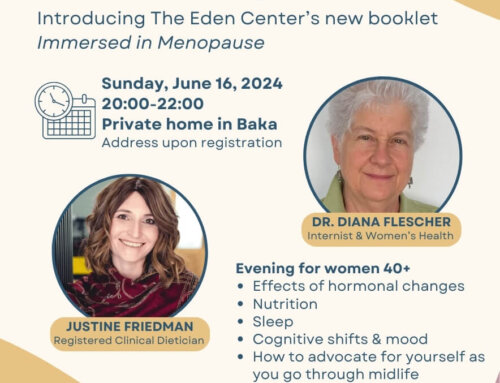
My memories of my menarche are challenging. During my teen years I suffered from horrible periods – excessive bleeding, acne, and pain so intense that I would have to leave school early or skip athletic events so I could lie down in a dark room until it passed. Because my periods were irregular, I never left the house without ibuprofen – if I didn’t take it immediately at the onset of cramping, I would be doubled over in pain within the hour. Shortly before my 18th birthday, my mother took me to the gynecologist, and after a quick blood draw, I was handed a diagnosis – polycystic ovary syndrome (PCOS). I would later learn that approximately 1 in 10 women are diagnosed with PCOS, and the course of treatment is almost always the same – hormonal birth control pills.
I would remain continuously on hormonal birth control for the next 12 years, until I got married and wanted to get pregnant. I didn’t think much of it, as nearly all of my friends were on hormonal birth control at the time – some for irregular periods like me, others because they were sexually active, a few for acne. For years I would carry my little pack of pills with me everywhere, dutifully swallowing one when my phone alarm went off, until I eventually switched to a hormonal IUD for convenience, and then I barely thought about it at all.
It wasn’t until after the birth of my first daughter that I began to seriously question the normalization of hormonal birth control in our society. In order to get pregnant I had utilized cycle tracking for the first time, and I learned that it was possible to know exactly when I was going to ovulate based on just a few simple markers – the position of my cervix, the composition of my cervical fluid, and my basal body temperature. This method of tracking is called the “Fertility Awareness Method,” or FAM, and can be used both in order to increase one’s chances of conceiving, as well as to prevent pregnancy. It wasn’t even complicated. I tracked my body temperature with a wearable thermometer every night and learned to read the changing signs in the color and consistency of vaginal discharge.
As I began to dig deeper, I was blown away by how little I actually knew about my own female physiology. What I used to think of as an isolated unit – the ovaries and uterus – was, in fact, working in beautiful synchronicity with my entire endocrine system. The endocrine system is made up of more than 50 different hormones, and these hormones influence almost every aspect of our health – metabolism, blood pressure, growth and development, sexual function and reproduction, our sleep, and our mood. Our menstrual cycles are one of the most important indicators of our overall health, and are referred to as the “6th vital sign” by the American College of Obstetricians and Gynecologists. In fact, our cycles “may even be one of the best ways to identify underlying imbalances not just in our female sex hormones, but throughout our entire body.”
The more I learned about the importance of healthy menstrual cycles, the more disturbed I became about my own medical history and treatment. While it is true that hormonal birth control can be very effective at reducing the symptoms of hormonal disorders (PMS, acne, irregular periods, heavy periods, PCOS, amenorrhea, etc.), it is not treating the root cause of these problems. By masking the symptoms of these conditions, many women operate for years under the false impression that their menstrual cycles have been “fixed,” only to have these problems come rushing back when they go off hormonal birth control when they decide to get pregnant. Many hormonal disorders can be improved with lifestyle changes, and these women will have been denied the opportunity to address these imbalances holistically, instead of hiding the problem with synthetic hormones. Many women are also not adequately educated about the potential side effects of hormonal birth control, such as depression, anxiety, fatigue, low libido, insomnia, and weight gain. Because so many women are put on hormonal birth control during their teen years before their cycles have a chance to regulate, they may not even realize that many of these symptoms are a result of their hormonal contraception.
It is not rare for women to be told by their gynecologists that they don’t “need” to have a period, or that ovulation doesn’t matter until they want to get pregnant. Taking multiple packs of pills in a row to suppress one’s period is common practice, and it is of course completely normalized (and often encouraged) to use hormones of various types for kallot to avoid a chuppat niddah. But how many of these women are educated about the potential side effects of hormonal birth control? What are we teaching young women when we tell them that their menstrual cycle, a key indicator of their physical and emotional health, is something that should be avoided or pushed away? In fact, we see such thinking in almost all aspects of women’s reproductive experience, from the widespread use of painkillers in childbirth, to the narrative that menopause is something that should be hidden and avoided through pharmacological means. The narrative is clear – one’s period, the symbol of womanhood, is an inconvenience to be opted out of or manipulated, rather than embraced.
Hormonal birth control has inarguably allowed for many advancements for women in modern society, and certainly it can be a helpful tool in many medical circumstances. However, this should not be at the cost of women and girls receiving appropriate sexual education or being given the tools to intimately know their own bodies and cycles. As a childbirth educator and (G-d willing) soon-to-be kallah teacher, I hope to speak about the menstrual cycle in a way that is positive and affirming, and to help remove shame from other aspects of women’s experiences related to their cycles. Connecting to the natural rhythms of our menstrual cycles can be an empowering experience that improves body image, sexual function, and mental health. I think that education around taharat ha-mishpacha and mikveh are potential avenues for this healing work to begin. G-d willing we will raise up the next generation of young women to have positive menarches, to feel in tune with their bodies and cycles, and to have the information they need to make empowered choices that are right for them and their families.
As for my own story, though I thank G-d did not have issues conceiving (many women with PCOS struggle with anovulation), I did have gestational diabetes in my first pregnancy. PCOS is a risk factor for gestational diabetes, and it was a wake-up call for me to make changes to my diet and lifestyle to prevent developing more serious metabolic dysfunction as I age. However, I can’t help but wonder how things would have looked if rather than covering up my symptoms with synthetic hormones, I would have been empowered with knowledge at a younger age? Would I still have gotten gestational diabetes if I had been forced to face the reality of my body’s imbalances and dysregulation years ago? One thing is for sure, I aim to educate my own children and kallot differently and give them the knowledge and choices I never had.
Alana Rahmani is the English Program Coordinator at The Eden Center. She is also a certified childbirth educator and is currently participating in The Eden Center’s kallah teacher training program. She lives in Jerusalem with her husband and two daughters.








Leave A Comment